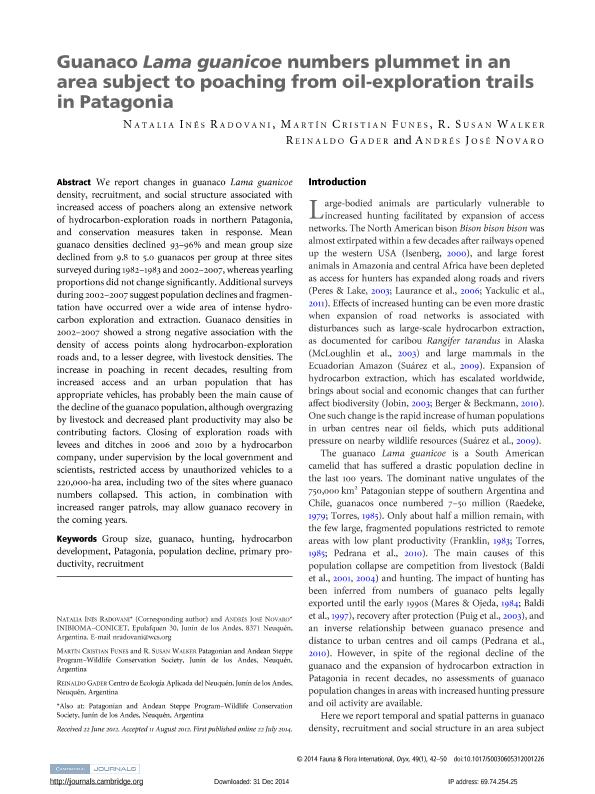Artículo
Guanaco Lama guanicoe numbers plummet in an area subject to poaching from oil-exploration trails in Patagonia
Radovani, Natalia Ines ; Funes, Martin Cristian; Walker, R. Susan; Gader, Reinaldo; Novaro, Andres Jose
; Funes, Martin Cristian; Walker, R. Susan; Gader, Reinaldo; Novaro, Andres Jose
 ; Funes, Martin Cristian; Walker, R. Susan; Gader, Reinaldo; Novaro, Andres Jose
; Funes, Martin Cristian; Walker, R. Susan; Gader, Reinaldo; Novaro, Andres Jose
Fecha de publicación:
12/2014
Editorial:
Cambridge University Press
Revista:
Oryx
ISSN:
0030-6053
Idioma:
Inglés
Tipo de recurso:
Artículo publicado
Clasificación temática:
Resumen
We report changes in guanaco Lama guanicoe density, recruitment, and social structure associated with increased access of poachers along an extensive network of hydrocarbon-exploration roads in northern Patagonia, and conservation measures taken in response. Mean guanaco densities declined 93?96% and mean group size declined from 9.8 to 5.0 guanacos per group at three sites surveyed during 1982?1983 and 2002?2007, whereas yearling proportions did not change significantly. Additional surveys during 2002?2007 suggest population declines and fragmentation have occurred over a wide area of intense hydrocarbon exploration and extraction. Guanaco densities in 2002?2007 showed a strong negative association with the density of access points along hydrocarbon-exploration roads and, to a lesser degree, with livestock densities. The increase in poaching in recent decades, resulting from increased access and an urban population that has appropriate vehicles, has probably been the main cause of the decline of the guanaco population, although overgrazing by livestock and decreased plant productivity may also be contributing factors. Closing of exploration roads with levees and ditches in 2006 and 2010 by a hydrocarbon company, under supervision by the local government and scientists, restricted access by unauthorized vehicles to a 220,000-ha area, including two of the sites where guanaco numbers collapsed. This action, in combination with increased ranger patrols, may allow guanaco recovery in the coming years.
Palabras clave:
Group Size
,
Guanaco
,
Hunting
,
Hydrocarbon Development
Archivos asociados
Licencia
Identificadores
Colecciones
Articulos(INIBIOMA)
Articulos de INST. DE INVEST.EN BIODIVERSIDAD Y MEDIOAMBIENTE
Articulos de INST. DE INVEST.EN BIODIVERSIDAD Y MEDIOAMBIENTE
Citación
Radovani, Natalia Ines; Funes, Martin Cristian; Walker, R. Susan; Gader, Reinaldo; Novaro, Andres Jose; Guanaco Lama guanicoe numbers plummet in an area subject to poaching from oil-exploration trails in Patagonia; Cambridge University Press; Oryx; 49; 12-2014; 42-50
Compartir
Altmétricas



